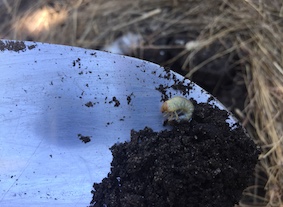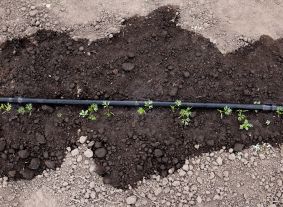Grubs In the Vegetable Garden
Views: 1657

Having grubs in the vegetable garden is a new experience for me. At my home in the country, grubs are all over the lawn, which I completely expected. But I didn’t expect them in a patch of fallow dirt that had been the previous owner’s (not very productive) vegetable patch.
I noted the grubs in the lawn last summer, the summer when I just haphazardly threw in some tomatoes into the bare vegetable patch and paid no attention to why they didn’t do well. I chose not to chemically treat the lawn for grubs because we have our own well, and I just didn’t want synthetic chemicals leaching into the groundwater.
This season I began going all in with the vegetable garden. When I noticed that some of the squashes and eggplant looked stunted and near death despite my close attention to watering and fertilizing, I knew to look at the roots. When I pulled up the poor-performing plants, each had large chunks of the root missing. PLUS each had a big fat white grub in the soil right next to it.
What Is a Grub?
A grub is the larval form of beetles, namely Japanese beetles, June beetles and others. The common ones are typically white and look like plump worms with a few pinching legs. The heads are brownish. They feed on the roots of plants and are often found as the offending culprits of brown or bare spots in lawns. Spotting grubs in the vegetable garden is more difficult as the only sign of them is poorly performing plants, after their damage is done, rather than a brown spot in a sea of green. I guess another sign is if you have quite a few birds visiting your garden who are happily lunching on something they are plucking from the dirt.
Natural Controls
Speaking with gardener friends with lawns (and hence the potential for grubs), they had so suggestions for natural controls for grubs:
Beneficial Nematodes. These are microscopic “worms” that seek out larvae and kill them. They don’t pose a risk to people, pets or plants so it’s a chemical- and worry-free strategy for eliminating grubs from the yard and garden. Once applied, the nematodes multiple their numbers and hence the effectiveness.
Milky Spores. This is actually a beneficial pathogen of grub larvae that is caused by Bacillus popilliae. It kills the grubs without harming anything else. The downside is it takes up to three or more years to become effective. The upside is, once established in the soil, it can stay effective for 10 or more years.
A friend was saying her brother uses both beneficial nematodes and milky spore as grub control measures and finds that super-effective. I like the idea of the double-barrel method of grub control—and I love the idea both are effective for many years.
So, how has this been working for me? Well, I have beneficial nematodes expected in the mail today. I’ll let you know how it goes.
Meet Ellen Wells
When you’re raised on a farm, you can’t help but know a thing or two about gardening. Ellen Wells is our expert on edible gardening.…
Ellen's Recent Posts

Asparagus






